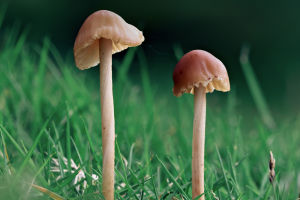Copperweed (Eupatorium coelestinum) is a stunning perennial plant that is native to North America.
It is well-known for its bright blue-purple flowers and is a popular choice for gardeners and landscapers.
However, there are several other plants that are often mistaken for copperweed due to their similar appearance.
In this article, we will explore five of these plants and their distinguishing characteristics.
1. Ironweed (Vernonia sp.)
Ironweed is a tall, erect perennial plant that is often mistaken for copperweed due to its similar height and appearance. Like copperweed, it produces clusters of purple flowers that attract butterflies and bees.
However, ironweed has a slightly different leaf structure, with toothed edges and a rough texture. Additionally, its stems are thicker and more rigid than those of copperweed.
2. Joe-Pye Weed (Eupatorium sp.)
Joe-Pye weed is another perennial plant that is often confused with copperweed. Like copperweed, it produces clusters of purple-pink flowers that bloom in late summer and fall. However, Joe-Pye weed is much taller than copperweed, often reaching heights of up to six feet.
Its leaves are also larger and have a more elongated shape. Additionally, Joe-Pye weed has a distinctive vanilla-like scent that sets it apart from copperweed.
3. Boneset (Eupatorium perfoliatum)
Boneset is a medicinal herb that is commonly mistaken for copperweed due to its similar appearance. It produces clusters of white flowers that bloom in late summer and fall and is often found growing in damp, marshy areas. Like copperweed, boneset has a square stem and opposite leaves.
However, its leaves are more pointed and have a serrated edge. Additionally, boneset has a bitter taste and is traditionally used to treat colds and fever.
4. Blue Mistflower (Conoclinium coelestinum)
Blue mistflower is a native perennial that is often confused with copperweed due to its similar name and appearance. It produces clusters of blue-purple flowers that bloom in late summer and fall and is often found growing in woodland areas. Like copperweed, blue mistflower has a square stem and opposite leaves.
However, its leaves are more lance-shaped and have a lighter green color. Additionally, blue mistflower has a slightly more delicate appearance than copperweed.
5. Wild Bergamot (Monarda fistulosa)
Wild bergamot, also known as bee balm, is a fragrant perennial plant that is sometimes mistaken for copperweed. It produces clusters of pink-purple flowers that bloom in mid-summer and is often found growing in meadows and prairies. Like copperweed, wild bergamot has a square stem and opposite leaves.
However, its leaves are more narrow and have a slightly fuzzy texture. Additionally, wild bergamot has a distinctive spicy aroma that sets it apart from copperweed.
While copperweed is a beautiful and distinctive plant, there are several other species that can be mistaken for it. By understanding the distinguishing characteristics of these plants, you can better identify them and appreciate their unique qualities.
Whether you are a gardener, naturalist, or simply someone who enjoys the beauty of nature, these plants are sure to delight and inspire you.


